Hermann J. Wiemer Vineyard
by
Kathy
Sullivan
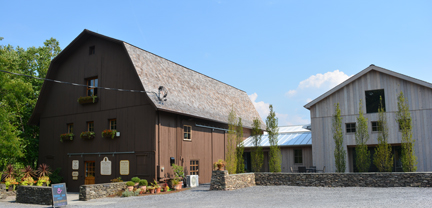 Summary: Hermann J. Wiemer is a well known, respected name in the Finger Lakes. During a visit to the Finger Lakes’ wineries, visitors are likely to hear the winery mentioned with a sense of respect and honor for the award winning wines produced.
Summary: Hermann J. Wiemer is a well known, respected name in the Finger Lakes. During a visit to the Finger Lakes’ wineries, visitors are likely to hear the winery mentioned with a sense of respect and honor for the award winning wines produced.
The Hermann J. Wiemer tasting room is located in a subdued transformed barn building. A sign on the exterior reads, “This Winery was established in 1979 from the first vinifera plantings on Seneca Lake. It was founded on knowledge gained from a 300 year family tradition of making only the finest wines in the Mosel Region of Germany combined with the skills and modern techniques of the New World.”
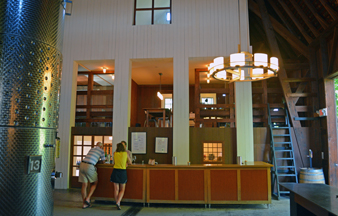 Inside, the interior of the barn has been renovated. A large white facade resembling a white barnside adds to the ambiance. Rustic-type hanging lights add to the attractiveness of the room. A large diagram displayed on the wall shows the location of the grape varieties in the vineyards. The winery is adjacent to the tasting room. During our visit we saw a large, upright, wine filter and numerous gleaming stainless steel tanks.
Inside, the interior of the barn has been renovated. A large white facade resembling a white barnside adds to the ambiance. Rustic-type hanging lights add to the attractiveness of the room. A large diagram displayed on the wall shows the location of the grape varieties in the vineyards. The winery is adjacent to the tasting room. During our visit we saw a large, upright, wine filter and numerous gleaming stainless steel tanks.
Potted Grapevines
Near two of the tasting room doors, hand-grafted potted grapevines are available for purchase. If you have a green thumb, you may be tempted to purchase a grapevine or two with which to experiment. The experience may provide a look at the beauty of the vines and perhaps a look at the difficulties a vineyardist faces.
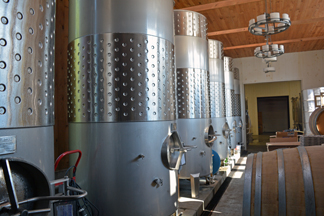 History of Hermann J. Wiemer
History of Hermann J. Wiemer
The story of the Hermann J. Wiemer winery began in Germany. The winery was started by Hermann Wiemer who arrived in the United States from Germany during the 1960s. Hermann’s maternal family had been producing wine for centuries. His father was deeply involved in viticulture. In Germany, Hermann was an assistant winemaker but he decided to travel to the United States to do his own winemaking. Before starting the Hermann J. Wiemer winery, Hermann was the winemaker at the Bully Hill winery. Hermann began his own winery in 1979.
Vineyards at Hermann J. Wiemer
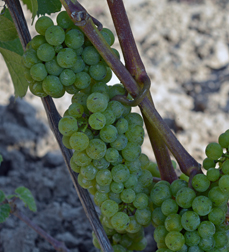 The winery owners in the past and today focus as much on viticulture as on oenology. Winemaking is based on the vineyard grapes. Currently the winery has 76 acres of grapevines that include 49 acres of Riesling (pictured). Other varieties include Chardonnay, Pinot Noir, Gewürztraminer, Grüner Veltliner, and Cabernet Franc. The winery has three vineyards: Josef Vineyard, Magdalena Vineyard and Hermann J. Wiemer Vineyard or HJW. Josep and Magdalena are the names of Hermann’s parents.
The winery owners in the past and today focus as much on viticulture as on oenology. Winemaking is based on the vineyard grapes. Currently the winery has 76 acres of grapevines that include 49 acres of Riesling (pictured). Other varieties include Chardonnay, Pinot Noir, Gewürztraminer, Grüner Veltliner, and Cabernet Franc. The winery has three vineyards: Josef Vineyard, Magdalena Vineyard and Hermann J. Wiemer Vineyard or HJW. Josep and Magdalena are the names of Hermann’s parents.
In 2015 Fred Merwarth is the winemaker. He majored in business and studied abroad in Germany where he discovered the enjoyment of wines. Fred began winemaking for Hermann in 2004. In 2007, Fred Merwarth and Oskar Bynke purchased the winery. Today the winery is producing 17,000 cases.
The Wines of Hermann J. Wiemer
In addition to still wines, the winery also produces several sparkling wines. Cuvée Brut 2011 was produced with a blend of Chardonnay and Pinot Noir. The sparkling wine has a dosage of 3 grams per liter residual sugar. Blanc de Blanc 2009 was produced with 100 percent Chardonnay. The wine produced in the traditional method was disgorged in January 2015. It was a light yellow with a lively mouthfeel and notes of apple and citrus. Brut Rosé 2009 was 100% Pinot Noir. This sparkling wine was orange with a pink hue and offered notes of raspberries.
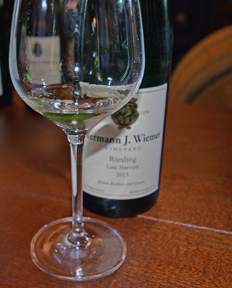 The largest production and best selling wine is the Dry Riesling. The 2014 had 12% alcohol with 9 grams of residual sugar per liter. The light yellow wine offered aroma notes of floral, tropical fruits, and peaches. The taste was smooth with peaches and roses. The finish was crisp with fruit and a hint of mineral. HJW Vineyard Riesling 2013 had 80 grams per liter of residual sugar. The pale yellow wine was very aromatic; it made me smile. The taste was sweet with notes of peach. The finish was dry and lingered. The Riesling 2013, produced with fruit from the Magdalena Vineyard, had 90 grams residual sugar per liter. The pale yellow wine offered an aroma with hints of peach, pear and mild melon. The taste was sweetish with melon and white peach notes. The finish lingered. Riesling 2013 from Josep Vineyards offered notes of mineral. The light yellow wine was sweeter and included notes of peach, melon and pear. The aftertaste lingered. Consider this wine for use as a dessert wine.
The largest production and best selling wine is the Dry Riesling. The 2014 had 12% alcohol with 9 grams of residual sugar per liter. The light yellow wine offered aroma notes of floral, tropical fruits, and peaches. The taste was smooth with peaches and roses. The finish was crisp with fruit and a hint of mineral. HJW Vineyard Riesling 2013 had 80 grams per liter of residual sugar. The pale yellow wine was very aromatic; it made me smile. The taste was sweet with notes of peach. The finish was dry and lingered. The Riesling 2013, produced with fruit from the Magdalena Vineyard, had 90 grams residual sugar per liter. The pale yellow wine offered an aroma with hints of peach, pear and mild melon. The taste was sweetish with melon and white peach notes. The finish lingered. Riesling 2013 from Josep Vineyards offered notes of mineral. The light yellow wine was sweeter and included notes of peach, melon and pear. The aftertaste lingered. Consider this wine for use as a dessert wine.
When traveling to wineries along the delightful, photographic Seneca Lake, be sure to save time for a visit to the Hermann J. Weimer winery.
Hermann J. Weimer Vineyard
3962 Rte. 14
Dundee, New York 14837
GPS: N42º 34.344’ W76º 55.725’
Article written September 2015
